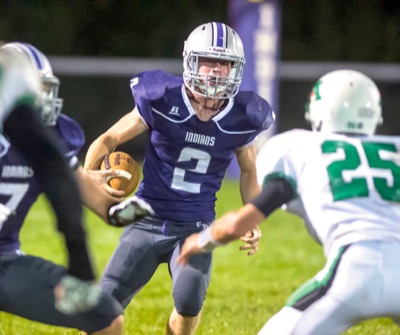Thursday, September 24th, 2015
Demand for officials remains high
Average age increases; overall numbers decrease
By Colin Foster

Photo by Nick Wenning/The Daily Standard
Football officials talk to the captains from Marion Local, left, and Beallsville before the teams' Week Two game this season. The number of officials in a majority of OHSAA-sanctioned sports has declined over the past five years with the average age of officials increasing.
This is the first in a periodical series about high school officiating. The first part looks at the aging of current officials, especially in football and the trouble in finding new officials
They're sometimes referred to as "Blue" or "Stripes" or "Zebras," and, despite being the most unbiased presence in the sporting arena or on the field, some of them would probably tell you they've been called a few other choice words that they don't wish to say out loud.
They enforce the rules of the game while ensuring the safety of the athletes in their respective sports. And they earn their stripes every time out.
Of course, the topic at hand is officials - and the need remains strong throughout various platforms in Ohio High School Athletic Association sanctioned athletics.
With the number of sports that are being played year-round in various age levels, there's no better time to be an official than now.
If you're an avid follower of high school sports, it's likely that you've seen the same refs calling games you've attended. Heck, you've probably even disagreed with a call or two of theirs at some point. People get into officiating for different reasons, but the vast majority of them will tell you this: they don't do it for the money - they're not making that much - but rather to remain a part of the games they love.
Deron Bailey, secretary/treasurer of the Western Ohio Football Officials Association (Lima based), has been a licensed football referee for 23 years and a baseball umpire for 13 years. Bailey is one of many good officials in Northwest Ohio who has dedicated his time to becoming better at his craft. For the better part of a decade, Bailey has instructed football classes for students trying to get licensed.
"At some point in our lives, we can't play the game anymore. We're done playing but if you want to stay in the game and be part of it, well give officiating a shot," Bailey said. "You're still on the field, still a big part of the game. There is nothing bigger than Friday nights. Once the officiating bug bites you, it bites hard and you'll be all in, but it's a lot of hard work and you'll need to dedicate yourself to the study of the rules books."
As for local official Garry Mosier, he knew he wanted to get into officiating following his last high school football game. Twenty-plus years later as a football and baseball official, Mosier is still going strong, also serving as an instructor for football and secretary of the Midwest Buckeye Football Officials Association.
"I played football and I wasn't going to be good enough to go on to the next level," Mosier explained. "It's not like golf where you can play it the rest of your life. Your last football game in high school, for 99 percent of the people, that's the last time you're ever going to be part of the game as a participant. If you have a passion for football or any kind of sport and you want to stay involved more so than being just a fan, you know, football officiating is a great thing to get into. It's good exercise.
"You've definitely got to be in shape, especially nowadays with spread offenses and things like that, and it is a way to make some money."
Officials aren't getting rich by any means. When they factor in the money spent on gas and food during road trips to wherever they are assigned, that game check usually turns into a little extra pocket cash.
"Some guys call me and ask about how much money you get from each school and I always tell them about how much you earn at each level but also explain to them that if they're getting into it to make a lot of money to not get into officiating," Bailey said. "You won't get rich but you'll make some extra spending money. But it's not about the money. It's about getting bitten by the officiating bug and it's in our blood!"
Several other benefits do come with getting involved in officiating. For starters, it's a way to keep up your physical and mental conditioning and stay busy in your downtime. It's a new challenge, and it's also an avenue that leads to making friendships, something that holds especially true in football, according to Dr. Bruce Mauer, OHSAA Director of Officiating Development.
"(In football) we use the 'crew concept,' especially for varsity games, and we'll have crews that will be together for 15, 20, 25 years," Mauer explained. "So what you do in football is you get the feeling of camaraderie and teamwork, and you get life-long friendships."
Veterans like Mosier and Bailey have paid their dues and plan to hang up their whistles one day. And although they've both loved the ride - the time spent under the Friday night lights of countless football fields in Ohio, the wild environments at games and the friends they've made - Mosier and Bailey would like to see a younger wave of refs join the ranks before they step out the door, particularly in football, where the average age for officials is over 50.
Mosier and Bailey were alarmed recently by the lack of students in their classes. For the first time in seven years, Mosier had zero students sign up for his class and Bailey had just three.
"The biggest factor I'm concerned about is I'm 54 years old and I'm at the end of the 'baby boomers,' and I'm told the highest average age of officials is about 53-54 years old. I've been in the bubble for a long time and I don't see the younger guys coming out who are interested in going out for officiating," Mosier said.
"Right now, my worst fear is that we are all getting older and there are not enough younger officials coming in so we won't have enough officials to go around to officiate all of the games," Bailey said. "Probably, in the next 10 years, we will have a mass exodus of officials hanging it up. If we don't get younger guys to join, then schools will be in big trouble. So right now, there are huge opportunities for those individuals getting into officiating."
Dr. Mauer said he has heard comments like these regularly in his 40-some-year career in officiating. He said that while it's definitely something to be aware of, the numbers of new officials taking classes statewide is a wash - some are up and some are down.
The active number of baseball umpires dipped from 4,248 in 2010-11 to 3,821 this past season, with the lowest total being 3,621 in 2013-14. The number of fastpitch softball umps dropped from 3,117 in 2010 to just 2,710 last year. Football officiating has also seen a steady decline, dropping from 3,723 in 2010-11 to 3,451 in 2014-15. The same holds true in volleyball, wrestling and track and field.
The total number of licensed officials was 16,629 in 2010-11. As of May 15, 2015, that number was 15,018 - the lowest total in five years.
"As you can see, while numbers in new students dropped for a few years, they are back on the rise," said OHSAA Officiating Registrar Ben Ferree via email. "This is a standard trend we see in the office - when the economy is bad, we get a lot of new officials. When the economy starts to get good again, we get and retain less."
As long as there are games to cover, the demand and opportunities for officials will remain high. Prospective officials can start working at an early age, too (most sports require a prospect to be 16 years of age). Those looking to get involved in officiating don't have to spend a huge portion of their time away from their full-time jobs, either. You'll learn all you need to know in just a few short hours over the span of a month or two.
In those classes, students learn how to deal with emotionally charged situations, how to get games, where to purchase uniforms and equipment, where to find a local officials/umpires association and all related information to have an opportunity for success. The goal of each instructor is to provide every student with enough knowledge and proficiency to be successful at entry-level officiating, Mosier said.
Students are expected to be proficient in reading and writing, and may also have to run and be engaged in physical activity. Therefore they should be ambulatory and have the necessary level of physical fitness required for that sport, Mosier added. Classes are expected to be attended.
A small instructional fee is required upon sign-up (differs per class and includes OHSAA permit and rule books fees). At the conclusion of classes and prior to their first game assignment, students are expected to purchase their own equipment and uniform. Students must be proficient in mechanics and rules of the respective sport. In order to earn their license, students must receive a 75 percent or higher on two written, final exams: one on rules and the other on mechanics.
Once a license is attained, new officials will have an avenue of opportunities open up during their careers, depending on how skillful, reliable and well respected they become by their peers. They will also have the chance to hone their craft by attending local rules meetings and clinics.
"It takes years to become a quality official," said Bailey, "and the northwest area has many good officials who have officiated for high school, college and the NFL."



